I hope I am NOT trying to be innovative
or has nothing to do .. but this issue is essentially affecting everyone.
Just treat this as an extension for our Thai amulet site. I would think one common
issue that every collector need to address is to get an acceptable way in a rightful
pronunciation from Thai to English with the various image form (as well as locations
of some landmarks such as Thai temples (Wat) as well as names of the many Thai Guru
Monks. Like it or not, this is an issue constantly faced by all amulet users/collectors
- for an instance, via any popular search engine, various acceptable interpretations/pronunciation
in English may yield different results. Anyway, I will try to provide a general guide
and suggest some of you to adopt a common pronunciation. If some of you have objections
or has a better term to suggest for the inclusion into this mini-database, please
make use of the Message Board to relay your opinion. Thanks.
Benchaphakhi should be the correct word to
use as officially in 1995, Thailand Post has officially published a series of commemorative
stamp set for this issue. But many sites are using "Benjapakee"
to refer to the top five Thai original amulet forms of Soomdej, Soomkor, Nang Phrya,
Pongsuphan and Phra Rod. When I have the time, I will featured that later in this
site.
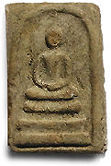 |
|
Phra (or "Pra") Soomdej. The most acceptable
pronunciation used for this form is SOOMDEJ / Soomdej, others may pronounce
it as SOOMDET/soomdet or Somdej. Wat Rakang was termed as Wat Rakhang
by some Thai or short as WRK. I would suggest standardization of Soomdej
for all. |
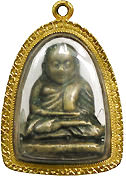 |
|
LP Ngern was commonly used for this image form. Some sites suggest the word
LP Nern. LP simply stands for Luang Phor* or pronounce
it as Long Phor, Loong Phur or Luong Por. Actually, Ruong Phor
is also usable (& more accurate) but I would think we use "Luang Phor"
from here onwards. |
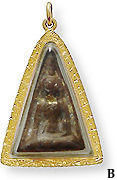 |
I pronounce this image form as Nang Phrya.
Some sites use Nang Pra Yah , Nang Praya or Nang Phya.
The latter sounds more appropriate but I would suggest the first. i.e. Nang Phrya |
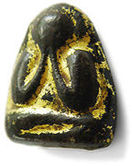 |
|
Phra (or "Pra") Pitta. Other
common pronunciation used are Pidha, Pita or Phra Pidda. I would
think Pidha was appropriate and most accurate. |
|
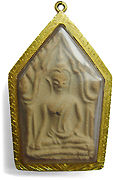 |
 |
Phra Khun
Paen was one image that has the most standard
pronunciation among all web resources. That is good. The only difference is the "Pra"
and "Phra". |
|
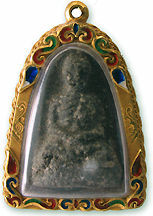 |
LP Thuad is used here in my site. Other commonly used terms are LP Tuad,
Luang Phor Thuat or even LP Duat. I would suggest everyone to use LP Thuad.
|
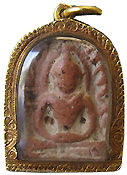 |
|
Phra Soomkor is an important (equally popular) Buddhist image.
Common variables such as Soomgor, Zoomkhor or even Somkhor were
being used. I prefer Soomkor. |
|
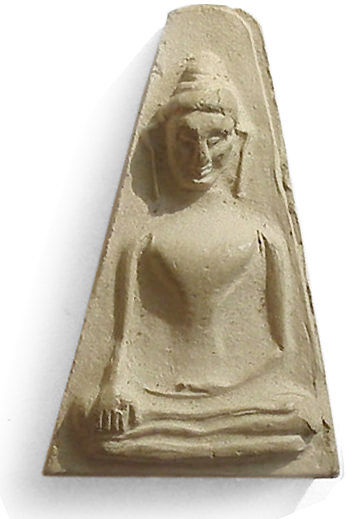 |
Phongsuparn was another that has quite a few
variations. Others like Phongshupharn, Pongsupan. I think the "Parn"
at the rear sounds more accurate, so, I would suggest retaining Phongsuparn. |
|
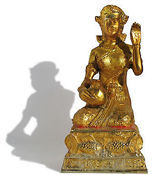 |
|
NangKwak was first used in Lek's site. I have seen some Thai written in Nangkuak
or Nangkwat. But I prefer the Nang Kwak so as not to raise further confusion. |
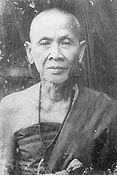 |
|
Khruba Srivichai. The first word was the confusing one that can be
pronounced as Kruba, Krubah or Gruba, Grubah and even
nearer as Grubah & Ghruba. I prefer Khruba. |
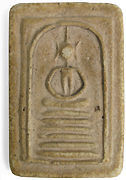
|
|
Kes Chaiyo has been pronounced as Gaet Chaiyo,
ketcheiyo or ketchaiyo by some. Some popular sites like Lek uses Kes
Chaiyo and I think no pint arguing which versions to use as it may even make things
more complicated. I would suggest just retain one as KesChayo or Kes Chaiyo. |
Others (Part One): "To" also referred as "Toh".
Guman Thong also being used as Guman Tong or Kuman Thong or
Dong by some. The most acceptable is the first. "Katha" is
used most often,some other acceptable terms is "Khata" or Ghata".
Phra Kaew may be used as Phra Keao - both are frequently used even by tour sites.
|
|
* "LUANG PHI" is classified for a young monk; "LUANG
PHO / LUANG PHOR" is classified for a middle aged monk; "LUANG PU / LUANG
POO" is classified for a old renowned monk; "LUANG TA" ( classified
for becoming a monk at older age ) is less respectful that "LUANG PHO / LUANG
PHOR"; "LUANG THERA" is classified for a man being a monk for 10 years.
Source:- yianhoe.com
Home
- Photography in Malaysia



Credit: To all the good
people who have contributed their own experience, resources or those who are kind
enough in granting us the permission to use their images that appeared on this site.
Mr. Wichian
Phetratanamunee® (+6-012-2612207
(Malaysia);+66(0)74-421248 Thailand), my master and mentor all these years.
My friend, Mr. Ho
Fook Sang® from Ipoh, Perak
(+06-0125388633,
+605-5415433)
who has been helping me all this long with wonderful source of information on Thai
Buddha Imageries; my partner, Mr. Paul Lim, who shares the same passion
together with me. Uncle
Lim®, from TONG SOON
Trading,
Pudu Plaza (+06-012-9128391) who has given
me some guidance relating to the background of some of the Thai amulets and lastly,
Miss MaeV who helped me
edit and patching some mistakes found on some of the pages in this site. Mr. Alan Tan "Arohka®" who contributes
some of his excellent articles fro this site, Mr. Weerapong Srivichai®, (+6609999974) from Chiangmai
News Co. Ltd. who has inspired me with so many new findings on Thai Amulets; Mr.
"Ben", Col. Samay, Mdm Wannee, Mr. Adisak® & many others
(such as Stan Thong (StanSLThong@yahoo.com), Raymond Goh(rockraymond168@yahoo.com), Tony
EH (tony_itf@yahoo.com)etc...
who share so much passion towards construction of this website and not to mention
all the time and effort spent by volunteered Co-Maintainers of the Message Board. Note: Certain content
and images appeared on this site were taken by using a Canon PowerShot Pro-1, G2
and Sony digital cameras. Some materials appeared on this site were scanned from
some leaflets, brochures or publications published in Thai and/or contribution from
surfers who claimed originality of their work for educational purposes. The creator
of the site will not be responsible for any discrepancies that may arise from such
dispute except rectifying them after verification. Site made with an Apple IMac.










